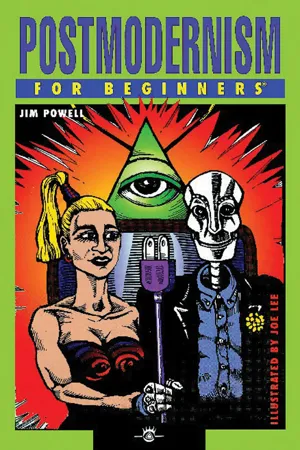
- 176 pages
- English
- ePUB (mobile friendly)
- Available on iOS & Android
eBook - ePub
Postmodernism For Beginners
About this book
If you are like most people, you’re not sure what Postmodernism is. And if this were like most books on the subject, it probably wouldn’t tell you.
Besides what a few grumpy critics claim, Postmodernism is not a bunch of meaningless intellectual mind games. On the contrary, it is a reaction to the most profound spiritual and philosophical crisis of our time – the failure of the Enlightenment.
Jim Powell takes the position that Postmodernism is a series of “maps” that help people find their way through a changing world. Postmodernism For Beginners features the thoughts of Foucault on power and knowledge, Jameson on mapping the postmodern, Baudrillard on the media, Harvey on time-space compression, Derrida on deconstruction and Deleuze and Guattari on rhizomes. The book also discusses postmodern artifacts such as Madonna, cyberpunk, Buddhist ecology, and teledildonics.
Besides what a few grumpy critics claim, Postmodernism is not a bunch of meaningless intellectual mind games. On the contrary, it is a reaction to the most profound spiritual and philosophical crisis of our time – the failure of the Enlightenment.
Jim Powell takes the position that Postmodernism is a series of “maps” that help people find their way through a changing world. Postmodernism For Beginners features the thoughts of Foucault on power and knowledge, Jameson on mapping the postmodern, Baudrillard on the media, Harvey on time-space compression, Derrida on deconstruction and Deleuze and Guattari on rhizomes. The book also discusses postmodern artifacts such as Madonna, cyberpunk, Buddhist ecology, and teledildonics.
Frequently asked questions
Yes, you can cancel anytime from the Subscription tab in your account settings on the Perlego website. Your subscription will stay active until the end of your current billing period. Learn how to cancel your subscription.
No, books cannot be downloaded as external files, such as PDFs, for use outside of Perlego. However, you can download books within the Perlego app for offline reading on mobile or tablet. Learn more here.
Perlego offers two plans: Essential and Complete
- Essential is ideal for learners and professionals who enjoy exploring a wide range of subjects. Access the Essential Library with 800,000+ trusted titles and best-sellers across business, personal growth, and the humanities. Includes unlimited reading time and Standard Read Aloud voice.
- Complete: Perfect for advanced learners and researchers needing full, unrestricted access. Unlock 1.4M+ books across hundreds of subjects, including academic and specialized titles. The Complete Plan also includes advanced features like Premium Read Aloud and Research Assistant.
We are an online textbook subscription service, where you can get access to an entire online library for less than the price of a single book per month. With over 1 million books across 1000+ topics, we’ve got you covered! Learn more here.
Look out for the read-aloud symbol on your next book to see if you can listen to it. The read-aloud tool reads text aloud for you, highlighting the text as it is being read. You can pause it, speed it up and slow it down. Learn more here.
Yes! You can use the Perlego app on both iOS or Android devices to read anytime, anywhere — even offline. Perfect for commutes or when you’re on the go.
Please note we cannot support devices running on iOS 13 and Android 7 or earlier. Learn more about using the app.
Please note we cannot support devices running on iOS 13 and Android 7 or earlier. Learn more about using the app.
Yes, you can access Postmodernism For Beginners by Jim Powell,Joe Lee in PDF and/or ePUB format, as well as other popular books in Philosophie & Moderne Philosophie. We have over one million books available in our catalogue for you to explore.
Information
What Is Postmodernism?

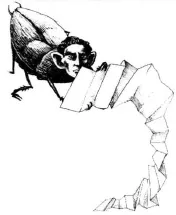

IHAB HASSAN
One Postmodern theorist, Ihab Hassan, offers a table of differences between the two movements:
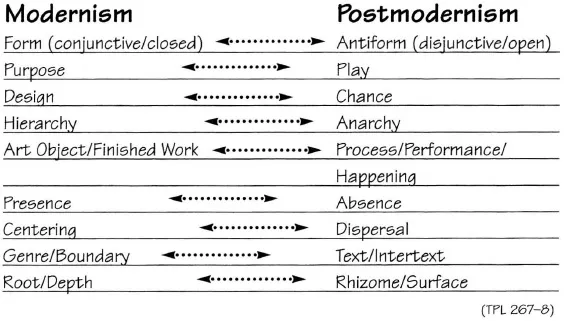
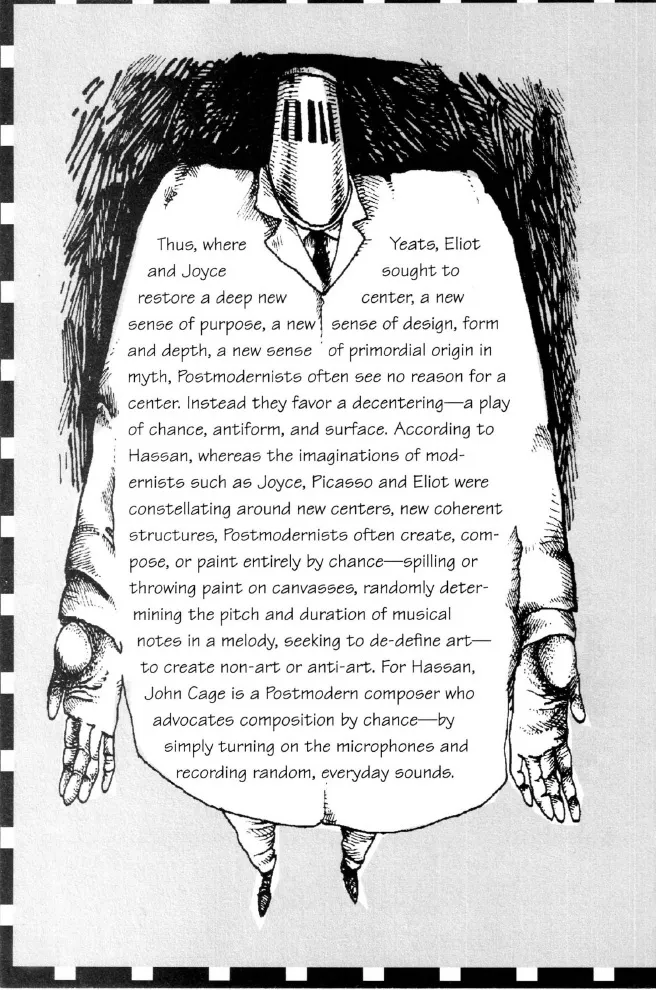

THE MAP-MAKERS
Important Postmodern Thinkers
Jean-Francois Lyotard


For some 15 years he was associated with a leftist group called Socialism or Barbarism, which, among other things, criticized Soviet-style communism. Although Lyotard became disillusioned with socialism and Marxism as early as 1964, the events of the student revolt in Paris, in May of 1968, confirmed his unrest.
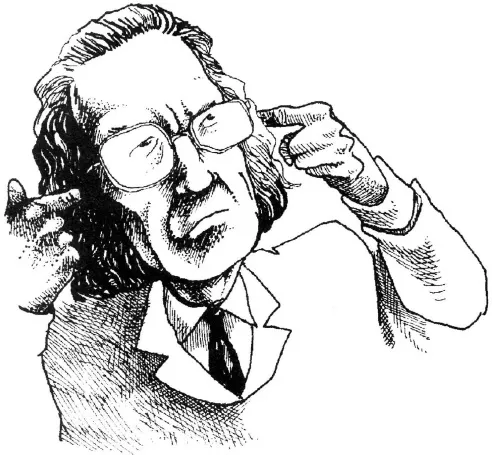
Discourse, figure
In 1971 we find him beginning a long, post-Marxist period in which he is given to thinking about philosophy, language and the arts. His book Discourse, figure, argues with the concept put forth by Jacques Lacan that the unconscious mind is like a language. Instead, Lyotard suggests that the unconscious is not so much like a language as it is visual and figural, like the figures one draws or paints. Language, after all, is flat, two dimensional. It represses desire. Dreams, on the other hand, are visual, figural, alive with three-dimensional dream figures, and dripping with desire. Like much modern painting, dreams are fragmented. In their attempt to make unconscious material visual, dreams disrupt the kind of linear awareness that language requires. The visual, figure-making nature of the unconscious, though at work within language, disrupts language, disrupts the rational order of language. This is because the figural nature of the unconscious is difficult to represent in language.

The figural resists representation in the same sense that the Holocaust resists representation. At Auschwitz the Nazis would drown out the screams of the victims in the death camps by playing music loudly. Similarly, to attempt to represent Auschwitz in language—to reduce the degradation, death and stench to a concept—drowns out the screams. According to Lyotard, it is therefore necessary that the Holocaust remains immemorial—that it remains being that which cannot be remembered—but also that which cannot be forgotten. Thus, any art attempting to represent the Holocaust should continue to haunt us with its inability to represent the unrepresentable, to say the unsayable. It should continue to haunt us with the feeling that there is something Other than representation.
Lyotard offers the example of Masaccio’s Trinity, painted on the walls of Santa Maria Novella, in Florence, which displays both medieval and Renaissance elements. By attempting to present two impossibly different eras, the painting seems to say that there is always an Other which cannot be truly represented.
Another example Lyotard offers is Cezanne’s Mont Saint-Victoire—a simultaneous attempt to present two different modes of vision: vision with a distinct focal center and vision which is peripheral, diffuse, indistinct. Again, two heterogeneous elements.
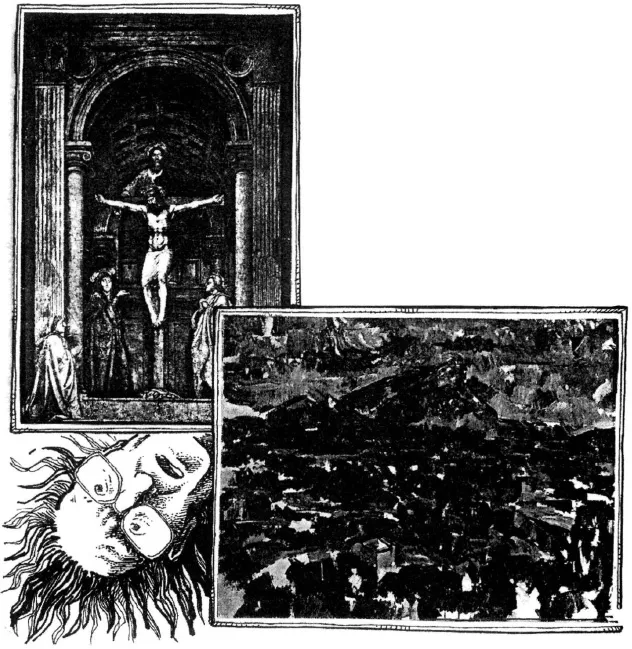


Poetic metaphor accomplishes the same. When I say “my love is a rose” I am invoking a heterogeneous difference. After all, a rose and my love may have very little in common.
Because all these works of art bring our attention to the Other, to a radical difference, they are political.

The Postmodern Condition
In 1974, the year Postmodern novelist Thomas Pynchon’s Gravity’s Rainbow, won the National Book Award, “streaking” became a fad in the United States, Mama Cass of the Mamas and the Papas choked to death on a sandwich, and a Soviet probe touched down on Mars, Lyotard gained international fame for The Postmodern Condition: a report on knowledge, an account commissioned by the Council of Universities of the Quebec government. The report surveys the status of science and technology, and has become something of a bible of Postmodernism.
Lyotard argues that for the past few decades science has increasingly investigated language, linguistic theories, communications, cybernetics, informatics, computers and computer languages, information storage, data banks, and problems of translation from one computer language to another. He proclaimed that these technological changes would have a major impact on knowledge.
Thus, in 1974 he predicted that no knowledge will survive that cannot be translated into computer language—into quantities of information. Learning will no longer be associated with the training of minds—with teachers training students. For the transmission and storage of information will no longer depend on individuals, but on computers. Information will be produced and sold. Nations will fight for information the way they used to fight for territory. Information will zip around the globe at the speed of electricity, and people will try to steal it. The role of the state will grow weaker. Taking the place of states, huge multinational corporations will dominate.

But having said all this about the direction of scientific knowledge, Lyotard adds that scientific knowledge is not the only kind of knowledge. His interest, it turns out, is not so much in scientific knowledge and the scientific method, per se, but in how scientific knowledge and method legitimize themselves—how they make themselves believable and trustworthy. And at this point Lyotard makes a distinction between scientific talk and narrative talk. Of course he doesn’t use the word “talk.” He uses scientific “discourse” and narrative “discourse.”



Table of contents
- Coverpage
- Titlepage
- Copyright
- Dedication
- Table of Contents
- Introduction
- Postmodernese
- What Is Modernism?
- What Is Postmodernism?
- Modernist Architecture
- Postmodern Architecture and Art
- Poststructuralism
- David Harvey
- Postmodern Artifacts
- Postmodern Environmentalism
- What is Postmodernism? (In Retrospect)
- References
- Index